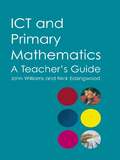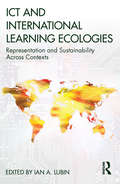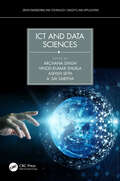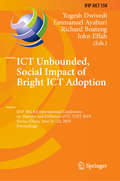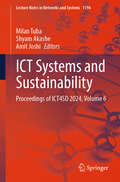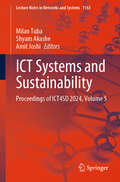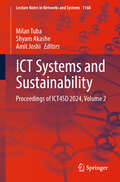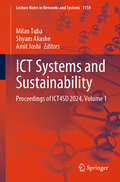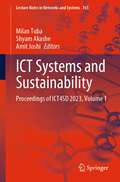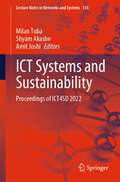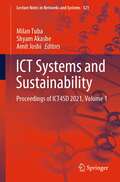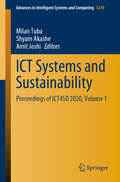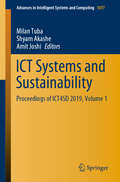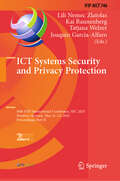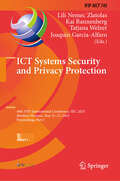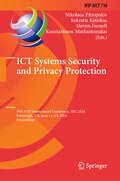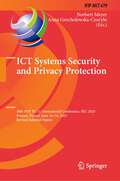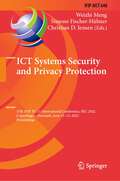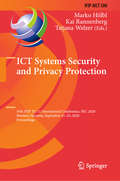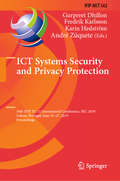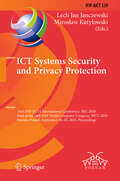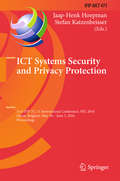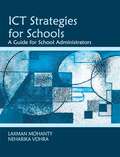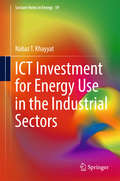- Table View
- List View
ICT and Primary Mathematics: A Teacher's Guide
by John Williams Nick EasingwoodThis book is for teachers who are looking for interesting and practical ways to incorporate ICT into their daily lesson plans. It shows how ICT can be used as a tool for mathematics, but more importantly how its proper use can enhance the mathematics being taught. The authors cover all current aspects of ICT and mathematics, including: databases spreadsheets logo and the use of floor turtles and control technology handling of resources including interactive whiteboards management of ICT within the classroom how ICT can be used to present mathematical topics and links to other areas of the curriculum. With plenty of suggestions on how to use the software and hardware described in the book, this is a useful resource for all primary teachers, particularly subject co-ordinators for ICT and mathematics. It will also be of interest to students on PGCE and Initial Teacher Training courses.
ICT and International Learning Ecologies: Representation and Sustainability Across Contexts
by Ian A. LubinICT and International Learning Ecologies addresses new ways to explore international, comparative, and cultural issues in education and technology. As today’s development orthodoxies push societies around the world to adopt imported information communication tools, new approaches are needed that integrate cultural responsiveness, autonomy, and sustainability into technology-enhanced learning. This edited collection conceptually and methodologically reframes the complexities of teaching and learning in historically marginalized communities around the world, where inequities are often exacerbated by one-size-fits-all programs. Graduate students and researchers of educational technology, international/comparative education, and sustainability education will be better prepared to lead information and communication technologies (ICT) implementation across a range of contexts and learner identities.
ICT and Data Sciences (Green Engineering and Technology)
by Archana Singh Ashish Seth Vinod Kumar Shukla A. Sai SabithaThis book highlights the state-of-the-art research on data usage, security, and privacy in the scenarios of the Internet of Things (IoT), along with related applications using Machine Learning and Big Data technologies to design and make efficient Internet-compatible IoT systems. ICT and Data Sciences brings together IoT and Machine Learning and provides the careful integration of both, along with many examples and case studies. It illustrates the merging of two technologies while presenting basic to high-level concepts covering different fields and domains such as the Hospitality and Tourism industry, Smart Clothing, Cyber Crime, Programming, Communications, Business Intelligence, all in the context of the Internet of Things. The book is written for researchers and practitioners, working in Information Communication Technology and Computer Science.
ICT Unbounded, Social Impact of Bright ICT Adoption: IFIP WG 8.6 International Conference on Transfer and Diffusion of IT, TDIT 2019, Accra, Ghana, June 21–22, 2019, Proceedings (IFIP Advances in Information and Communication Technology #558)
by Yogesh Dwivedi Emmanuel Ayaburi Richard Boateng John EffahThis book constitutes the refereed proceedings of the IFIP WG 8.6 International Working Conference "ICT Unbounded, Social Impact of Bright ICT Adoption" on Transfer and Diffusion of IT, TDIT 2019, held in Accra, Ghana, in June 2019. The 30 revised full papers and 4 short papers presented were carefully reviewed and selected from 72 submissions. The papers focus on Bright Information and Communication Technology, a concept that entails the development of relevant technologies, business models, public policies, social norms, international agreements, metrics of measuring national progress and preventing undesirable activities on the Internet. They are organized in the following topical sections: technology adoption, diffusion and ubiquitous computing; big data and business intellligence; smart cities; and security, privacy, ethics and misinformation.
ICT Systems and Sustainability: Proceedings of ICT4SD 2024, Volume 6 (Lecture Notes in Networks and Systems #1194)
by Amit Joshi Shyam Akashe Milan TubaThis book proposes new technologies and discusses future solutions for ICT design infrastructures, as reflected in high-quality papers presented at the 8th International Conference on ICT for Sustainable Development (ICT4SD 2024), held in Goa, India, on 8–9 August 2024. The book covers the topics such as big data and data mining, data fusion, IoT programming toolkits and frameworks, green communication systems and network, use of ICT in smart cities, sensor networks and embedded system, network and information security, wireless and optical networks, security, trust, and privacy, routing and control protocols, cognitive radio and networks, and natural language processing. Bringing together experts from different countries, the book explores a range of central issues from an international perspective.
ICT Systems and Sustainability: Proceedings of ICT4SD 2024, Volume 5 (Lecture Notes in Networks and Systems #1163)
by Amit Joshi Shyam Akashe Milan TubaThis book proposes new technologies and discusses future solutions for ICT design infrastructures, as reflected in high-quality papers presented at the 8th International Conference on ICT for Sustainable Development (ICT4SD 2024), held in Goa, India, on 8–9 August 2024. The book covers the topics such as big data and data mining, data fusion, IoT programming toolkits and frameworks, green communication systems and network, use of ICT in smart cities, sensor networks and embedded system, network and information security, wireless and optical networks, security, trust, and privacy, routing and control protocols, cognitive radio and networks, and natural language processing. Bringing together experts from different countries, the book explores a range of central issues from an international perspective.
ICT Systems and Sustainability: Proceedings of ICT4SD 2024, Volume 2 (Lecture Notes in Networks and Systems #1160)
by Amit Joshi Shyam Akashe Milan TubaThis book proposes new technologies and discusses future solutions for ICT design infrastructures, as reflected in high-quality papers presented at the 8th International Conference on ICT for Sustainable Development (ICT4SD 2024), held in Goa, India, on 8–9 August 2024. The book covers the topics such as big data and data mining, data fusion, IoT programming toolkits and frameworks, green communication systems and network, use of ICT in smart cities, sensor networks and embedded system, network and information security, wireless and optical networks, security, trust, and privacy, routing and control protocols, cognitive radio and networks, and natural language processing. Bringing together experts from different countries, the book explores a range of central issues from an international perspective.
ICT Systems and Sustainability: Proceedings of ICT4SD 2024, Volume 1 (Lecture Notes in Networks and Systems #1159)
by Amit Joshi Shyam Akashe Milan TubaThis book proposes new technologies and discusses future solutions for ICT design infrastructures, as reflected in high-quality papers presented at the 8th International Conference on ICT for Sustainable Development (ICT4SD 2024), held in Goa, India, on 8–9 August 2024. The book covers the topics such as big data and data mining, data fusion, IoT programming toolkits and frameworks, green communication systems and network, use of ICT in smart cities, sensor networks and embedded system, network and information security, wireless and optical networks, security, trust, and privacy, routing and control protocols, cognitive radio and networks, and natural language processing. Bringing together experts from different countries, the book explores a range of central issues from an international perspective.
ICT Systems and Sustainability: Proceedings of ICT4SD 2023, Volume 1 (Lecture Notes in Networks and Systems #765)
by Amit Joshi Shyam Akashe Milan TubaThis book proposes new technologies and discusses future solutions for ICT design infrastructures, as reflected in high-quality papers presented at the 8th International Conference on ICT for Sustainable Development (ICT4SD 2023), held in Goa, India, on 3–4 August 2023. The book covers the topics such as big data and data mining, data fusion, IoT programming toolkits and frameworks, green communication systems and network, use of ICT in smart cities, sensor networks and embedded system, network and information security, wireless and optical networks, security, trust, and privacy, routing and control protocols, cognitive radio and networks, and natural language processing. Bringing together experts from different countries, the book explores a range of central issues from an international perspective.
ICT Systems and Sustainability: Proceedings of ICT4SD 2022 (Lecture Notes in Networks and Systems #516)
by Amit Joshi Shyam Akashe Milan TubaThis book proposes new technologies and discusses future solutions for ICT design infrastructures, as reflected in high-quality papers presented at the 7th International Conference on ICT for Sustainable Development (ICT4SD 2022), held in Goa, India, on 29–30 July 2022. The book covers the topics such as big data and data mining, data fusion, IoT programming toolkits and frameworks, green communication systems and network, use of ICT in smart cities, sensor networks and embedded system, network and information security, wireless and optical networks, security, trust, and privacy, routing and control protocols, cognitive radio and networks, and natural language processing. Bringing together experts from different countries, the book explores a range of central issues from an international perspective.
ICT Systems and Sustainability: Proceedings of ICT4SD 2021, Volume 1 (Lecture Notes in Networks and Systems #321)
by Amit Joshi Shyam Akashe Milan TubaThis book proposes new technologies and discusses future solutions for ICT design infrastructures, as reflected in high-quality papers presented at the 6th International Conference on ICT for Sustainable Development (ICT4SD 2021), held in Goa, India, on 5–6 August 2021. The book covers the topics such as big data and data mining, data fusion, IoT programming toolkits and frameworks, green communication systems and network, use of ICT in smart cities, sensor networks and embedded system, network and information security, wireless and optical networks, security, trust, and privacy, routing and control protocols, cognitive radio and networks, and natural language processing. Bringing together experts from different countries, the book explores a range of central issues from an international perspective.
ICT Systems and Sustainability: Proceedings of ICT4SD 2020, Volume 1 (Advances in Intelligent Systems and Computing #1270)
by Amit Joshi Shyam Akashe Milan TubaThis book proposes new technologies and discusses future solutions for ICT design infrastructures, as reflected in high-quality papers presented at the 5th International Conference on ICT for Sustainable Development (ICT4SD 2020), held in Goa, India, on 23–24 July 2020. The conference provided a valuable forum for cutting-edge research discussions among pioneering researchers, scientists, industrial engineers, and students from all around the world. Bringing together experts from different countries, the book explores a range of central issues from an international perspective.
ICT Systems and Sustainability: Proceedings of ICT4SD 2019, Volume 1 (Advances in Intelligent Systems and Computing #1077)
by Amit Joshi Shyam Akashe Milan TubaThis book proposes new technologies and discusses future solutions for ICT design infrastructures, as reflected in high-quality papers presented at the 4th International Conference on ICT for Sustainable Development (ICT4SD 2019), held in Goa, India, on 5–6 July 2019. The conference provided a valuable forum for cutting-edge research discussions among pioneering researchers, scientists, industrial engineers, and students from all around the world. Bringing together experts from different countries, the book explores a range of central issues from an international perspective.
ICT Systems Security and Privacy Protection: 40th IFIP International Conference, SEC 2025, Maribor, Slovenia, May 21–23, 2025, Proceedings, Part II (IFIP Advances in Information and Communication Technology #746)
by Joaquin Garcia-Alfaro Tatjana Welzer Kai Rannenberg Lili Nemec ZlatolasThe two-volume set IFIP AICT 745 + 746 constitutes the refereed proceedings of the 40th IFIP International Conference on ICT Systems Security and Privacy Protection, SEC 2025, held in Maribor, Slovenia, during May 21-23, 2025. The 28 full papers and 7 workshop papers included in this book were carefully reviewed and selected from 127 submissions. They were organized in topical sections as follows: Privacy protection; Industrial and Critical Infrastructure Security; Applied Cryptography; Data and Application Security; and International Workshop on Network and Distributed Systems Security (WNDSS 2025).
ICT Systems Security and Privacy Protection: 40th IFIP International Conference, SEC 2025, Maribor, Slovenia, May 21–23, 2025, Proceedings, Part I (IFIP Advances in Information and Communication Technology #745)
by Joaquin Garcia-Alfaro Tatjana Welzer Kai Rannenberg Lili Nemec ZlatolasThe two-volume set IFIP AICT 745 + 746 constitutes the refereed proceedings of the 40th IFIP International Conference on ICT Systems Security and Privacy Protection, SEC 2025, held in Maribor, Slovenia, during May 21-23, 2025. The 28 full papers and 7 workshop papers included in this book were carefully reviewed and selected from 127 submissions. They were organized in topical sections as follows: Privacy protection; Industrial and Critical Infrastructure Security; Applied Cryptography; Data and Application Security; and International Workshop on Network and Distributed Systems Security (WNDSS 2025).
ICT Systems Security and Privacy Protection: 39th IFIP International Conference, SEC 2024, Edinburgh, UK, June 12–14, 2024, Proceedings (IFIP Advances in Information and Communication Technology #710)
by Steven Furnell Sokratis Katsikas Konstantinos Markantonakis Nikolaos PitropakisThis book constitutes the proceedings of the 39th IFIP International Conference on ICT Systems Security and Privacy Protection, SEC 2024, held in Edinburgh, UK, during June 12–14, 2024. The 34 full papers presented were carefully reviewed and selected from 112 submissions. The conference focused on current and future IT Security and Privacy Challenges and also was a part of a series of well-established international conferences on Security and Privacy.
ICT Systems Security and Privacy Protection: 38th IFIP TC 11 International Conference, SEC 2023, Poznan, Poland, June 14–16, 2023, Revised Selected Papers (IFIP Advances in Information and Communication Technology #679)
by Norbert Meyer Anna Grocholewska-CzuryłoThis book constitutes the refereed proceedings of the 38th IFIP TC 11 International Conference on Information Security and Privacy Protection, SEC 2023, held in Poznan, Poland, in June 2023. The 26 full papers included in this book were carefully reviewed and selected from 84 submissions. They focus on topics such as access control and authentication; applied cryptography; mobile security; side-channel attacks; trust management, digital forensics; industry networks security, etc.
ICT Systems Security and Privacy Protection: 37th IFIP TC 11 International Conference, SEC 2022, Copenhagen, Denmark, June 13–15, 2022, Proceedings (IFIP Advances in Information and Communication Technology #648)
by Simone Fischer-Hübner Weizhi Meng Christian D. JensenThis book constitutes the refereed proceedings of the 37th IFIP TC 11 International Conference on Information Security and Privacy Protection, SEC 2022, held in Copenhagen, Denmark, in June 2022. The 29 full papers presented were carefully reviewed and selected from 127 submissions. The papers present novel research on theoretical and practical aspects of security and privacy protection in information processing systems. They are organized in topical sections on privacy models and preferences; network security and IDS; network security and privacy; forensics; trust and PETs; crypto-based solutions; usable security; blockchain; mobile security and privacy; PETs and crypto; and vulnerabilities.
ICT Systems Security and Privacy Protection: 36th IFIP TC 11 International Conference, SEC 2021, Oslo, Norway, June 22–24, 2021, Proceedings (IFIP Advances in Information and Communication Technology #625)
by Lynn Futcher Audun Jøsang Janne HagenThis book constitutes the refereed proceedings of the 36th IFIP TC 11 International Conference on Information Security and Privacy Protection, SEC 2021, held in Oslo, Norway, in June 2021.*The 28 full papers presented were carefully reviewed and selected from 112 submissions. The papers present novel research on theoretical and practical aspects of security and privacy protection in ICT systems. They are organized in topical sections on digital signatures; vulnerability management; covert channels and cryptography; application and system security; privacy; network security; machine learning for security; and security management. *The conference was held virtually.
ICT Systems Security and Privacy Protection: 35th IFIP TC 11 International Conference, SEC 2020, Maribor, Slovenia, September 21–23, 2020, Proceedings (IFIP Advances in Information and Communication Technology #580)
by Tatjana Welzer Kai Rannenberg Marko HölblThis book constitutes the refereed proceedings of the 35th IFIP TC 11 International Conference on Information Security and Privacy Protection, SEC 2020, held in Maribor, Slovenia, in September 2020. The conference was held virtually due to the COVID-19 pandemic. The 29 full papers presented were carefully reviewed and selected from 149 submissions. The papers present novel research on theoretical and practical aspects of security and privacy protection in ICT systems. They are organized in topical sections on channel attacks; connection security; human aspects of security and privacy; detecting malware and software weaknesses; system security; network security and privacy; access control and authentication; crypto currencies; privacy and security management; and machine learning and security.
ICT Systems Security and Privacy Protection: 34th IFIP TC 11 International Conference, SEC 2019, Lisbon, Portugal, June 25-27, 2019, Proceedings (IFIP Advances in Information and Communication Technology #562)
by Gurpreet Dhillon Fredrik Karlsson Karin Hedström André ZúqueteThis book constitutes the refereed proceedings of the 34th IFIP TC 11 International Conference on Information Security and Privacy Protection, SEC 2019, held in Lisbon, Portugal, in June 2019.The 26 revised full papers presented were carefully reviewed and selected from 76 submissions. The papers present novel research on theoretical and practical aspects of security and privacy protection in ICT systems. They are organized in topical sections on intrusion detection, access control, organizational and behavioral, crypto and encryption, and integrity.
ICT Systems Security and Privacy Protection: 33rd IFIP TC 11 International Conference, SEC 2018, Held at the 24th IFIP World Computer Congress, WCC 2018, Poznan, Poland, September 18-20, 2018, Proceedings (IFIP Advances in Information and Communication Technology #529)
by Lech Jan Janczewski Mirosław KutyłowskiThis book constitutes the refereed proceedings of the 33rd IFIP TC 11 International Conference on Information Security and Privacy Protection, SEC 2018, held at the 24th IFIP World Computer Congress, WCC 2018, in Poznan, Poland, in September 2018.The 27 revised full papers presented were carefully reviewed and selected from 89 submissions. The papers present novel research on theoretical and practical aspects of security and privacy protection in ICT systems. They are organized in the following topical sections: authentication, failures of security management, security management/forensic, and software security/attacks.
ICT Systems Security and Privacy Protection
by Stefan Katzenbeisser Jaap-Henk HoepmanThis book constitutes the refereed proceedings of the 31st IFIP TC 11 International Conference on ICT Systems Security and Privacy Protection, SEC 2016, held in Ghent, Belgium, in May/June 2016. The 27 revised full papers presented were carefully reviewed and selected from 139 submissions. The papers are organized in topical sections on cryptographic protocols, human aspects of security, cyber infrastructure, social networks, software vulnerabilities, TPM and internet of things, sidechannel analysis, software security, and privacy.
ICT Strategies for Schools: A Guide for School Administrators
by Laxman Mohanty Neharika VohraRecognizing the potential of ICTs to make the classroom transaction of curriculum significantly more relevant and purposeful, principals and school administrators in India need to design appropriate IT strategies and oversee the entire implementation process in their schools. This book is guide to the use of ICT in schools, covering issues of pedagogy, curriculum and learning. In brief, it deals with - Education uses of IT - Criteria for selection of hardware and software - Designing an IT-assisted curriculum - Teacher recruitment, training and desired competencies - Management and financial issues - Possible problem areas: plagiarism, privacy, hacking Lucidly written, with case studies highlighting successful strategies, this volume will be of immense importance to principals and administrators of schools as also students of education.
ICT Investment for Energy Use in the Industrial Sectors
by Nabaz T. KhayyatThis book investigates the impact of production input factors on the market, consumer and producer energy demand characteristics in 30 industrial sectors for South Korea over the period 1980-2009, and for Japan over the period 1973-2006, with special emphasis placed on the effects of ICT investment on the demand for energy. A dynamic factor demand model is developed, accounting for the adjustment costs that are defined in terms of forgone output from current production. It addresses four key aspects of production and energy demand in manufacturing: first, it establishes the various relationships between different factors of production. Second, it investigates whether the energy demand in the industrial sectors in South Korea would be decreased or increased by substituting/complementing with other input factors such as ICT capital and labor. Third, it looks at sources of growth in the industrial sectors through decomposing the Divisia index based total factor productivity (TFP). Finally it provides appropriate policy recommendations based on these findings. The results of this study may provide industrial sectors' stakeholders and environmental and industrial policy makers with a flexible model that has the capacity to assess outcomes of various policies under certain scenarios. The factor demand methodology described in this book is very advanced and up-to-date. It can be used when teaching advanced graduate courses and in empirically advanced research. Therefore, it is highly relevant in both teaching as a main or supplementary text and in particular as a reference handbook in conducting empirical research. The focus on ICT effects on energy use makes this book an important addition to the existing literature on industrial development.
